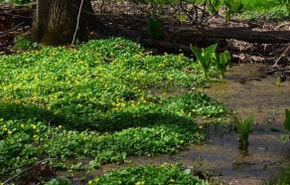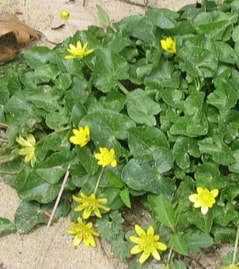|
Close up image of lesser celandine  Lesser celandine invades a natural area If you have taken a walk down by the creek in recent days there is a lovely flush of yellow flowers. Though pretty, lesser celandine/celandine buttercup (Ranunculus ficaria) is very invasive and crowds out our native plants. Lesser celandine spreads easily and once it takes hold, it can be hard to eradicate. Many people in our neighborhood have this invasive in their gardens.
The glossy leaves and eight-petal yellow flowers of this European perennial arrive in March and April before most spring ephemeral wildflowers. A rapid spreader, it's leaves create an impenetrable mat that blocks emerging wildflowers. Small bulblets at the base are easily dislodged by digging humans or animals. The bulblets and tuberous roots are often carried downstream by high waters from the wet areas it favors. Digging to remove it is possible only when the entire plant plus soil can be lifted. Lesser celandine goes dormant by early June. Any method of control for lesser celandine will require persistence and monitoring. Small infestations of lesser celandine can be controlled by hand digging. Care must be taken to remove as much of the plant material (including all root material, bulblets and tubers) as possible. Removed plant parts should be bagged and disposed of as garbage and should never be composted. Follow–up work will be required to control any plants that develop from missed plant parts. For more information about lesser celandine, please refer to the resources below: www.invasive.org/eastern/midatlantic/rafi.html extension.umd.edu/hgic/topics/lesser-celandine www.nwcb.wa.gov/images/weeds/Lesser-Celandine-Control_Whatcom.pdf www.invasive.org/weedcd/pdfs/wgw/lessercelandine.pdf |
Archives
April 2022
Categories |


 RSS Feed
RSS Feed

